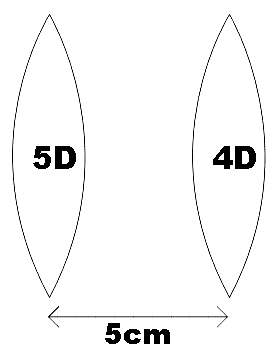
Two thin converging lenses of powers 5D and 4D are placed 5cm apart. The power of the combination is
A. 9D
B. 8D
C. 1D
D.20D
Answer
558.6k+ views
Hint: As a first step, you could find the focal lengths of each lens from the given values of their power. Now you could recall the expression for the power of the combination of two lenses that is separated by a distance d. Then you could directly substitute the given values from the question to get the answer.
Formula used:
Power of the combination of lenses separated by a distance d,
$P={{P}_{1}}+{{P}_{2}}-\dfrac{d}{{{f}_{1}}{{f}_{2}}}$
Complete step-by-step answer:
In the question, we are given two thin converging lenses, that is, two thin convex lenses of powers 5D and 4D. We are asked to find the power of the combination when they are kept co-axially at 5cm apart as shown in the figure given below.

On recalling the definition of power of a lens, we know that it is the reciprocal of focal length of the lens in meters. That is,
$P=\dfrac{1}{f}$ ……………………………. (1)
For the first lens whose power is 5D, the focal length will be given by the reciprocal of power, that is,
${{f}_{1}}=\dfrac{1}{5}=0.2m$ …………………………. (2)
Similarly for the second lens whose power is 4D, the focal length could be given by,
${{f}_{2}}=\dfrac{1}{4}=0.25m$ ……………………………. (3)
Now, let us recall the expression for the focal length$\left( f \right)$ of the combination of two lenses of focal lengths ${{f}_{1}}$ and${{f}_{2}}$ kept at $d$distance apart for thin lenses.
$\dfrac{1}{f}=\dfrac{1}{{{f}_{1}}}+\dfrac{1}{{{f}_{2}}}-\dfrac{d}{{{f}_{1}}{{f}_{2}}}$ ……………………………….. (4)
By using (1), (4) could be written as,
$P={{P}_{1}}+{{P}_{2}}-\dfrac{d}{{{f}_{1}}{{f}_{2}}}$ ………………………………….. (5)
Where, P is power of the combination and ${{P}_{1}}$ and ${{P}_{2}}$ are the powers of each lens.
The distance of separation of lenses are given as,
$d=5cm=0.05m$ ……………………………….. (6)
Now by substituting (2), (3) and (6) along with all the other values from the question, we get,
$P=5+4-\dfrac{0.05}{\left( 0.2\times 0.25 \right)}$
$\Rightarrow P=9-1$
$\therefore P=8D$
Therefore, we found the combination of the given lenses to have a power of 8D. Hence, option B is the right answer.
So, the correct answer is “Option B”.
Note: This question is solved based on the fact that the given lenses are kept co-axially and also they are both thin. If there had been no distance of separation between the two lenses their combination would have been the direct sum of the powers of the two lenses. Since a term $\left( \dfrac{d}{{{f}_{1}}{{f}_{2}}} \right)$ has to be subtracted from this sum to get the power of the combination when separated by a distance, we know that the power of combination is more in the case where the distance of separation is zero.
Formula used:
Power of the combination of lenses separated by a distance d,
$P={{P}_{1}}+{{P}_{2}}-\dfrac{d}{{{f}_{1}}{{f}_{2}}}$
Complete step-by-step answer:
In the question, we are given two thin converging lenses, that is, two thin convex lenses of powers 5D and 4D. We are asked to find the power of the combination when they are kept co-axially at 5cm apart as shown in the figure given below.

On recalling the definition of power of a lens, we know that it is the reciprocal of focal length of the lens in meters. That is,
$P=\dfrac{1}{f}$ ……………………………. (1)
For the first lens whose power is 5D, the focal length will be given by the reciprocal of power, that is,
${{f}_{1}}=\dfrac{1}{5}=0.2m$ …………………………. (2)
Similarly for the second lens whose power is 4D, the focal length could be given by,
${{f}_{2}}=\dfrac{1}{4}=0.25m$ ……………………………. (3)
Now, let us recall the expression for the focal length$\left( f \right)$ of the combination of two lenses of focal lengths ${{f}_{1}}$ and${{f}_{2}}$ kept at $d$distance apart for thin lenses.
$\dfrac{1}{f}=\dfrac{1}{{{f}_{1}}}+\dfrac{1}{{{f}_{2}}}-\dfrac{d}{{{f}_{1}}{{f}_{2}}}$ ……………………………….. (4)
By using (1), (4) could be written as,
$P={{P}_{1}}+{{P}_{2}}-\dfrac{d}{{{f}_{1}}{{f}_{2}}}$ ………………………………….. (5)
Where, P is power of the combination and ${{P}_{1}}$ and ${{P}_{2}}$ are the powers of each lens.
The distance of separation of lenses are given as,
$d=5cm=0.05m$ ……………………………….. (6)
Now by substituting (2), (3) and (6) along with all the other values from the question, we get,
$P=5+4-\dfrac{0.05}{\left( 0.2\times 0.25 \right)}$
$\Rightarrow P=9-1$
$\therefore P=8D$
Therefore, we found the combination of the given lenses to have a power of 8D. Hence, option B is the right answer.
So, the correct answer is “Option B”.
Note: This question is solved based on the fact that the given lenses are kept co-axially and also they are both thin. If there had been no distance of separation between the two lenses their combination would have been the direct sum of the powers of the two lenses. Since a term $\left( \dfrac{d}{{{f}_{1}}{{f}_{2}}} \right)$ has to be subtracted from this sum to get the power of the combination when separated by a distance, we know that the power of combination is more in the case where the distance of separation is zero.
Recently Updated Pages
Master Class 12 English: Engaging Questions & Answers for Success

Master Class 12 Business Studies: Engaging Questions & Answers for Success

Master Class 12 Economics: Engaging Questions & Answers for Success

Master Class 12 Social Science: Engaging Questions & Answers for Success

Master Class 12 Maths: Engaging Questions & Answers for Success

Master Class 12 Chemistry: Engaging Questions & Answers for Success

Trending doubts
Explain sex determination in humans with line diag class 12 biology CBSE

Explain sex determination in humans with the help of class 12 biology CBSE

Differentiate between homogeneous and heterogeneous class 12 chemistry CBSE

Dihybrid cross is made between RRYY yellow round seed class 12 biology CBSE

What is virtual and erect image ?

What is the Full Form of PVC, PET, HDPE, LDPE, PP and PS ?




